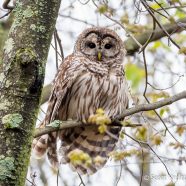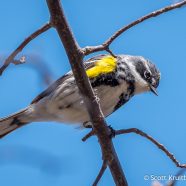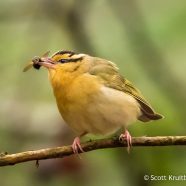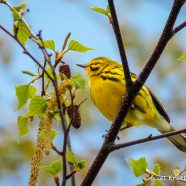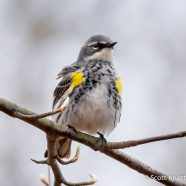Barred Owl (Strix varia)
This Barred Owl (Strix varia) saw me long before I saw it, monitoring my movements from afar while perched in this tree on a cloudy May morning. Those enormous dark eyes tracked me in a relaxed fashion as I was still rather far away when I noticed it. I had been watching several warblers and a Blue-gray Gnatcatcher before my eyes stumbled on this slightly larger species. Barred Owls are, of course, usually snoozing during the day, but not always – and the spring season is when I have seen them the most active diurnally. This bird did not wake up because I was there, nor was it sleepy....
Read MoreYellow-rumped Warbler
Here are a couple more stunning Yellow-rumped Warbler photos while they are looking so fantastic in their spring shades – and right before all the leaves pop out. They’ll be heading out soon as a greater diversity of warblers arrive in our backyards. I did see one unique Yellow-rumped Warbler yesterday that I will feature in an upcoming post… Scott Kruitbosch Conservation & Outreach Coordinator
Read MoreWorm-eating Warbler (Helmitheros vermivorum)
I was thrilled to find and then get great views of this Worm-eating Warbler (Helmitheros vermivorum) singing and feeding earlier today. I first heard its insect-like trill of a song from along a steep, rocky slope in the forest featuring a lot of vegetation in the understory – precisely what they want for the breeding season. We in the Northeast are at the northern edge of their range, and finding the uncommon birds can be difficult. Worm-eating Warbler populations are said to be stable, but they certainly do decline and increase in certain regions depending on local conditions....
Read MorePrairie Warbler (Setophaga discolor)
Here’s a Throwback Thursday to a Prairie Warbler (Setophaga discolor) that I photographed several years ago. The species begins to return to us in the Northeast right abouttttt…now! I hope to be able to spot one or two in migration so that I can get some better shots and enjoy their buzzy, rising song. Look for them in scrub or shrub habitat, old fields, power line cuts, or even forests – just not the prairies. Scott Kruitbosch Conservation & Outreach Coordinator
Read MoreYellow-rumped Warbler
Here it is, the most abundant warbler you will likely see this year – the Yellow-rumped Warbler. In this case the bird was not showing off where it got that name, and instead it fluffed up and shook off for a moment while still watching for prey. There were plenty of flying (and biting!) insects already in the air here in late April, and it along with dozens of others had their fill flitting through the forest canopy. You can also see the leaves beginning to emerge. In a couple of weeks there will be a lot of green across the landscape and views like this one will already be covered...
Read More



